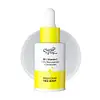What's inside
What's inside
 Key Ingredients
Key Ingredients

 Benefits
Benefits

 Concerns
Concerns

No concerns
 Ingredients Side-by-side
Ingredients Side-by-side

Water
Skin ConditioningNiacinamide
SmoothingSalicylic Acid
MaskingPropanediol
SolventCamellia Sinensis Extract
AntioxidantMelia Azadirachta Extract
Skin ConditioningSalix Alba Bark Extract
AstringentAloe Barbadensis Leaf Extract
EmollientSodium Lactate
BufferingSodium Gluconate
Skin ConditioningBetaine
HumectantPhenoxyethanol
PreservativeEthylhexylglycerin
Skin ConditioningSodium Hyaluronate
HumectantPanthenol
Skin ConditioningSodium Benzoate
MaskingPotassium Sorbate
PreservativeHeptyl Glucoside
Hydroxyethyl Urea
HumectantXanthan Gum
EmulsifyingAllantoin
Skin ConditioningMelaleuca Alternifolia Leaf Oil
AntioxidantTocopheryl Acetate
AntioxidantWater, Niacinamide, Salicylic Acid, Propanediol, Camellia Sinensis Extract, Melia Azadirachta Extract, Salix Alba Bark Extract, Aloe Barbadensis Leaf Extract, Sodium Lactate, Sodium Gluconate, Betaine, Phenoxyethanol, Ethylhexylglycerin, Sodium Hyaluronate, Panthenol, Sodium Benzoate, Potassium Sorbate, Heptyl Glucoside, Hydroxyethyl Urea, Xanthan Gum, Allantoin, Melaleuca Alternifolia Leaf Oil, Tocopheryl Acetate
Ingredients Explained
These ingredients are found in both products.
Ingredients higher up in an ingredient list are typically present in a larger amount.
Allantoin is a soothing ingredient known for its protective and moisturizingg properties. Because of this, it is often added to products with strong active ingredients.
Studies show higher concentrations of this ingredient can promote wound healing.
Though it can be derived from the comfrey plant, allantoin is produced synthetically for cosmetic products to ensure purity.
Learn more about AllantoinPhenoxyethanol is a preservative that has germicide, antimicrobial, and aromatic properties. Studies show that phenoxyethanol can prevent microbial growth. By itself, it has a scent that is similar to that of a rose.
It's often used in formulations along with Caprylyl Glycol to preserve the shelf life of products.
Propanediol is an all-star ingredient. It softens, hydrates, and smooths the skin.
It’s often used to:
Propanediol is not likely to cause sensitivity and considered safe to use. It is derived from corn or petroleum with a clear color and no scent.
Learn more about PropanediolThis is the synthetic salt of gluconic acid, a form of PHA and mild exfoliant.
It is mainly used to stabilize oil and butter formulations from going bad. Sodium gluconate is a humectant, pH regulator, and chelating agent.
Chelating agents help neutralize unwanted metals from affecting the formulation.
Sodium gluconate is water-soluble.
Learn more about Sodium GluconateSodium Hyaluronate is hyaluronic acid's salt form. It is commonly derived from the sodium salt of hyaluronic acid.
Like hyaluronic acid, it is great at holding water and acts as a humectant. This makes it a great skin hydrating ingredient.
Sodium Hyaluronate is naturally occurring in our bodies and is mostly found in eye fluid and joints.
These are some other common types of Hyaluronic Acid:
Learn more about Sodium HyaluronateWater. It's the most common cosmetic ingredient of all. You'll usually see it at the top of ingredient lists, meaning that it makes up the largest part of the product.
So why is it so popular? Water most often acts as a solvent - this means that it helps dissolve other ingredients into the formulation.
You'll also recognize water as that liquid we all need to stay alive. If you see this, drink a glass of water. Stay hydrated!
Learn more about WaterXanthan gum is used as a stabilizer and thickener within cosmetic products. It helps give products a sticky, thick feeling - preventing them from being too runny.
On the technical side of things, xanthan gum is a polysaccharide - a combination consisting of multiple sugar molecules bonded together.
Xanthan gum is a pretty common and great ingredient. It is a natural, non-toxic, non-irritating ingredient that is also commonly used in food products.
Learn more about Xanthan Gum